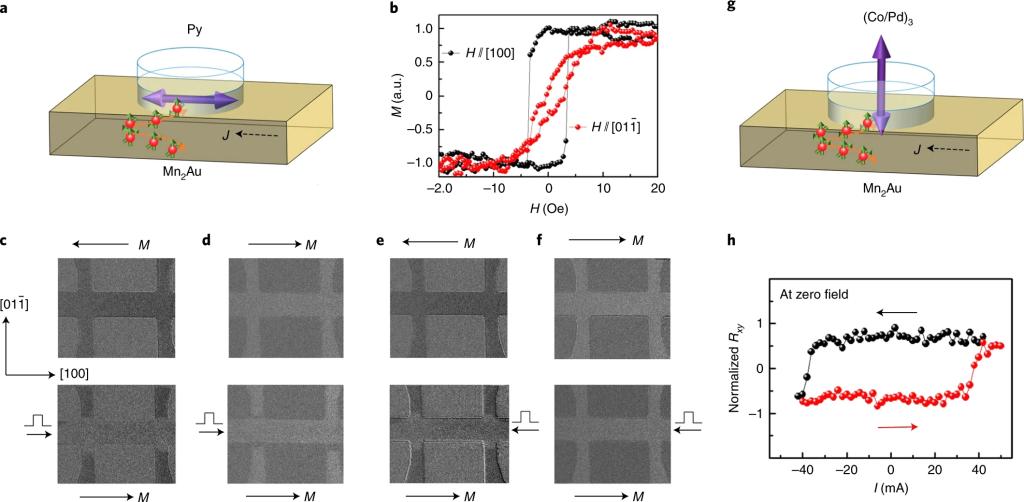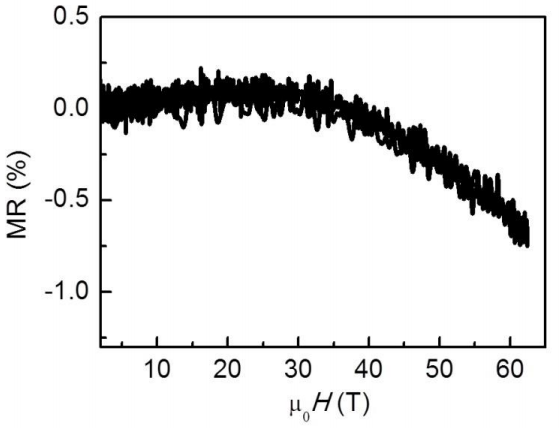
Schematic of the field-free type-x switching
Background
Spin currents generated by the charge current (Jx) in materials with strong spin-orbit coupling provides an attractive approach for the magnetization switching of nanomagnets, where the spin-orbit torque (SOT) serves as a promising building block for nonvolatile memories. The antiferromagnetic spin Hall effect (AFM-SHE) is expected to occur in antiferromagnets with spin conservation, which offers the unique possibility of an antiferromagnetic moment-dependent out-of-plane spin generator.
What we discover?
We report a magnetic spin Hall effect in a collinear antiferromagnet, Mn2Au. The spin currents are generated at two spin sublattices with broken spatial symmetry, and the antiparallel antiferromagnetic moments play an important role. Therefore, we term this effect the ‘antiferromagnetic spin Hall effect’. The out-of-plane spins from the antiferromagnetic spin Hall effect are favourable for the efficient switching of perpendicular magnetized devices, which is required for high-density applications. The antiferromagnetic spin Hall effect adds another twist to the atomic-level control of spin currents via the antiferromagnetic spin structure.
Why is this important?
We have demonstrated the AFM-SHE in collinear antiferromagnetic Mn2Au at room temperature via the space-broken symmetry of the spin sublattice. The generation of out-of-plane spin polarization strongly depends on the spin structure of Mn2Au; thus, the modulation of Mn2Au antiferromagnetic moments by both electric field and current can markedly tune the spin current and corresponding spin torque acting on the adjacent ferromagnetic layer. The field-free type-x and type-z SOT switching are unravelled in Mn2Au/ferromagnet stacks. In addition to Mn2Au, the AFM-SHE is expected to exist in collinear AFM systems with broken space-reversal symmetry such as CuMnAs and RuO2 (ref. 20). Our findings enrich the current understanding of spin-current physics and present a broad opportunity to use an out-of-plane polarized spin current in spintronic devices with ultrahigh density and high energy efficiency.
Why did we need WHMFC?
In this study, Professor Cheng Song, Hyunsoo Yang and Feng Pan test the stability of Mn2Au against magnetic fields, the resistance of 10 nm-thick Mn2Au films grown on PMN-PT(001) substrates was measured when scanning out-of-plane H from 0 to 62 Tesla (T) then back to 0. And find than Mn2Au is stable up to magnetic perturbation of 30 T, which is an attractive performance for antiferromagnet-based memories.

Magnetoresistance of Mn2Au at high magnetic fields. The out-of-planemagnetic field was swept from 0 to 62 Tesla and then back to 0.
Who did the research?
1. MOE Key Laboratory of Advanced Materials, School of Materials Science and Engineering, Beijing Innovation Center for Future Chips, Tsinghua University, Beijing, China
Xianzhe Chen, Cheng Song, Xiaofeng Zhou, Hua Bai, Liyang Liao, Yongjian Zhou & Feng Pan
2. Department of Electrical and Computer Engineering, National University of Singapore, Singapore, Singapore
Shuyuan Shi, Guoyi Shi & Hyunsoo Yang
3. NUS Graduate School for Integrative Sciences and Engineering, National University of Singapore, Singapore, Singapore
Guoyi Shi & Hyunsoo Yang
4. The Key Lab for Magnetism and Magnetic Materials of Ministry of Education, Lanzhou University, Lanzhou, China
Xiaolong Fan, Hanwen Zhang & Desheng Xue
5. Beijing Key Lab of Microstructure and Property of Solids, Institute of Microstructure and Properties of Advanced Materials, Beijing University of Technology, Beijing, China
Ang Li, Yanhui Chen & Xiaodong Han
6. Wuhan National High Magnetic Field Center and School of Physics, Huazhong University of Science and Technology, Wuhan, China
Shan Jiang & Zengwei Zhu
7. Institute of Microelectronics, Tsinghua University, Beijing, China
Huaqiang Wu
8. Physics Departmet, The Hong Kong University of Science and Technology, Hong Kong, China
Xiangrong Wang
Acknowledgments
We are grateful for fruitful discussions with J. Yin, D. Weiss, J. Han, K. Cai, P. He, S. D. Pollard and R. Mishra. This work is supported by the National Key R&D Program of China (grant no. 2017YFB0405704), National Natural Science Foundation of China (grant no. 51871130), Natural Science Foundation of Beijing Municipality (grant no. JQ20010) and National Key R&D Program of China (grants no. 2016YFA0203800 and 2017YFB0405604). X.R.W. is supported by Hong Kong RGC (grants no. 16301518 and 16301619).
Link
https://www.nature.com/articles/s41563-021-00946-z
